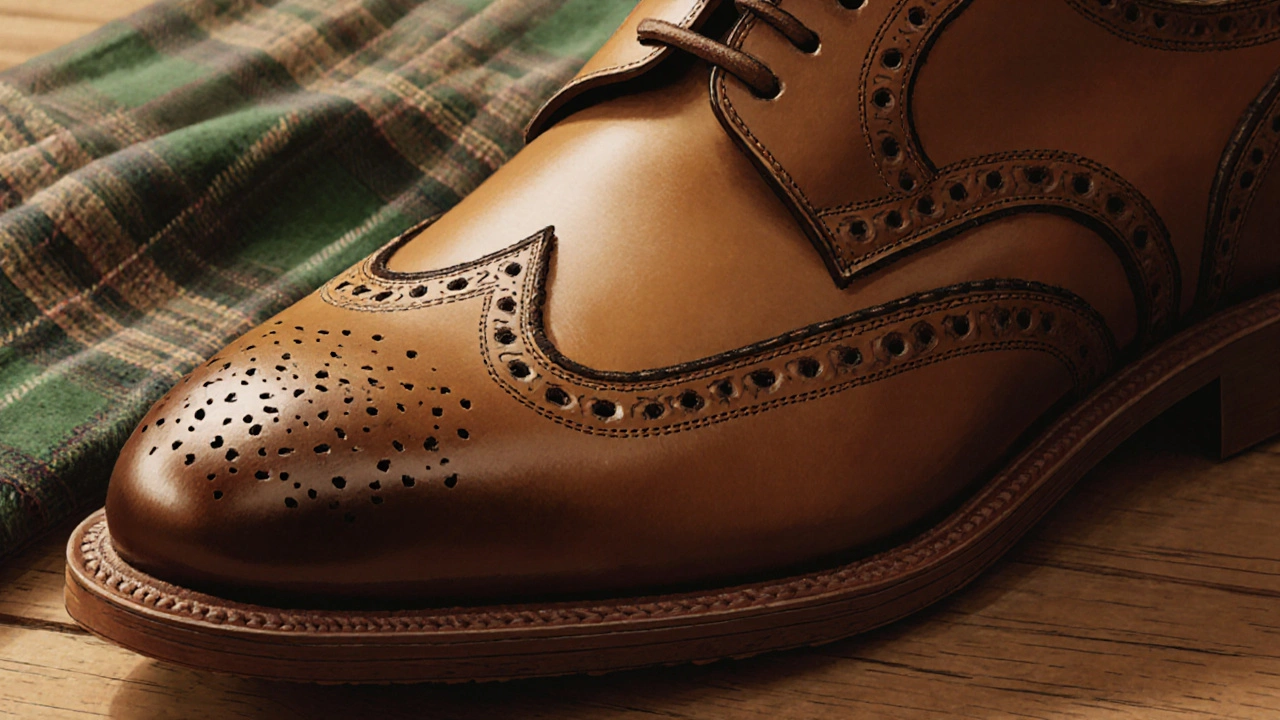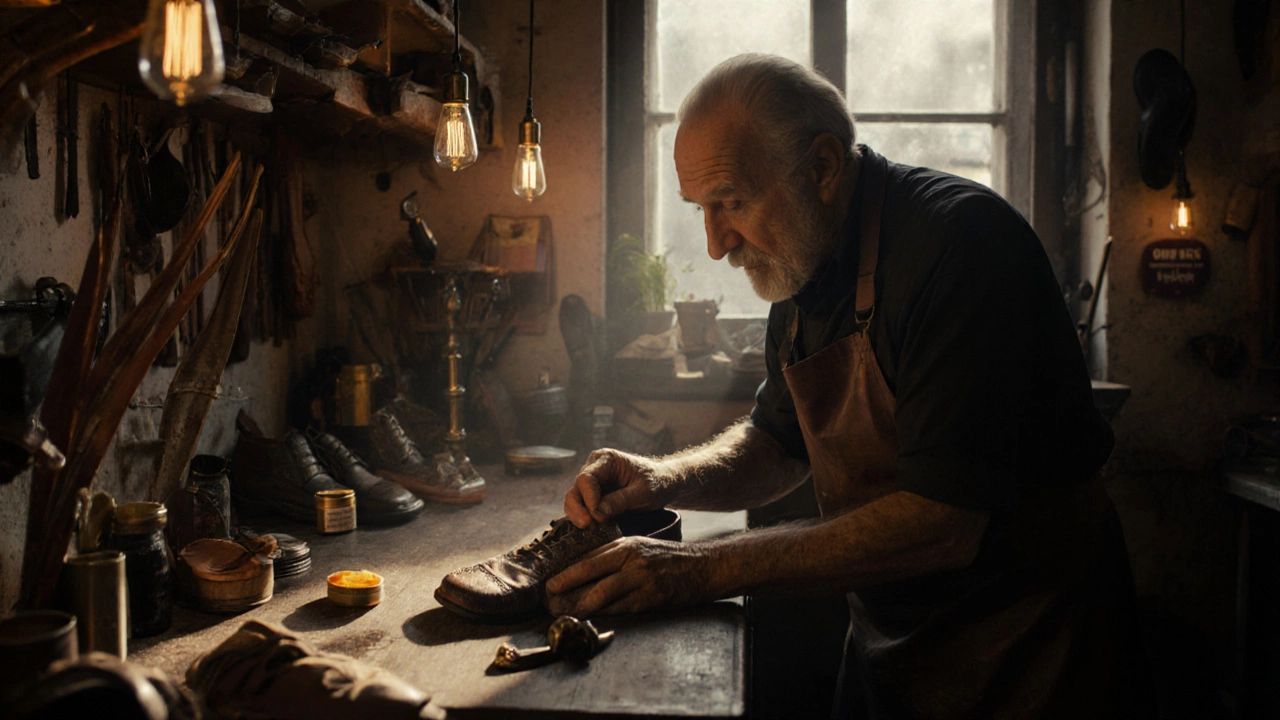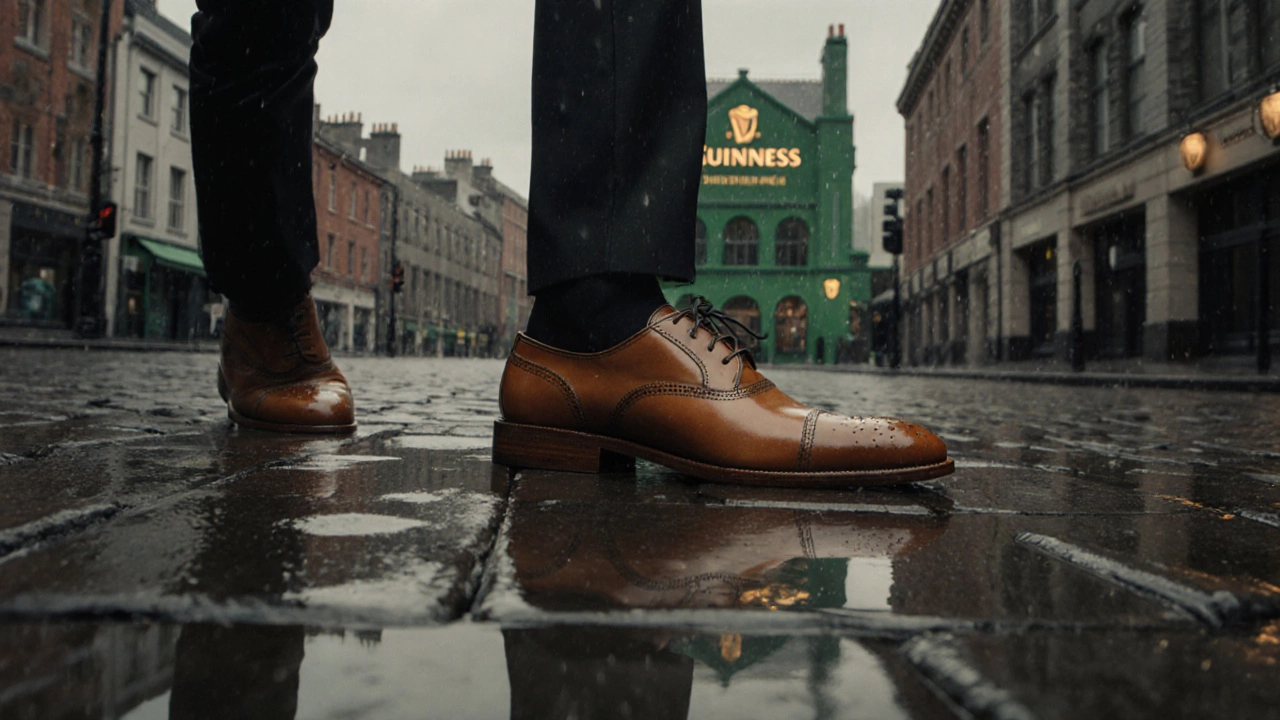Leather Shoes Selector for Ireland
Recommended Leather Shoe Style
Why This Choice Works for Ireland
Key Features of Quality Irish Leather Shoes
Water Resistance
Treated leather sheds water effectively, perfect for Ireland's unpredictable weather.
Sustainability
Vegetable-tanned leather from Irish tanneries reduces environmental impact.
Durability
With proper care, leather shoes last 10-15 years compared to 2-4 years for synthetics.
Comparison Table: Leather vs Synthetic
| Feature | Leather Shoes | Synthetic Shoes |
|---|---|---|
| Breathability | High – natural pores allow airflow | Medium – depends on material |
| Water Resistance | Good after conditioning | Varies; often less reliable in heavy rain |
| Longevity | 10-15 years with care | 2-4 years typical |
| Style Flexibility | Classic to contemporary | Limited to casual looks |
| Cost (EUR) | €150-€300 | €30-€100 |
Quick Takeaways
- Leather shoes handle Ireland’s wet climate better than most synthetics.
- They convey professionalism in Dublin’s business districts and authenticity at cultural events.
- Local Irish brands and repair services keep your pair looking sharp for years.
- Proper care-cleaning, conditioning, and storage-extends lifespan and comfort.
- Choosing the right style matches both casual Galway streets and formal Belfast venues.
When you hear someone talk about leather shoes in Ireland, you’re often hearing a mix of practicality, tradition, and style. From the rain‑slicked pavements of Dublin to the cobblestones of Killarney, a sturdy pair of leather footwear does more than finish an outfit - it protects your feet, signals respect, and ties you to a long‑standing Irish craft heritage.
Leather shoes are footwear made from animal hide that has been tanned, dyed, and stitched into a durable, breathable shoe. They have been a staple in Irish wardrobes for centuries, evolving from heavy work boots to sleek Oxfords and brogues.
Weather‑Proofing on the Emerald Isle
The Irish climate is famously unpredictable. A sunny morning in Cork can quickly turn into a drizzly afternoon, and the occasional gust off the Atlantic can make the ground slick. Leather naturally repels water after being treated with wax or oil, meaning a well‑conditioned pair stays drier than canvas sneakers.
In Dublin’s corporate quarter, professionals reach for polished leather Oxfords when heading to a meeting at the Guinness Storehouse or a client lunch on Harcourt Street. The material’s ability to dry quickly after a sudden shower keeps the shoes looking respectable without constant replacement.
Style Meets Heritage
Irish fashion prides itself on a blend of modern trends and historic motifs. Leather shoes fit perfectly into this narrative. A classic brogue, with its decorative perforations, nods to the intricate lacework of Donegal sweaters. When you wear them at a St.Patrick’s Day parade in Belfast, you’re not just dressed for the occasion-you’re echoing a lineage of craftsmanship that dates back to the leather tanneries along the River Lee.
Local brands such as James Taylor in Dublin craft hand‑stitched leather shoes that celebrate Irish design. Their “Celtic Knot” line features subtle embroidery inspired by ancient stone carvings, offering a conversation piece for any pub‑side chat.

Economic and Sustainable Reasons
Investing in quality leather shoes can be cheaper in the long run. While a pair might cost €150-€250 up‑front, the durability means fewer replacements. Irish tanneries in County Cork use vegetable‑based processes that reduce chemical waste, making the product more environmentally friendly than many mass‑produced synthetic shoes.
Furthermore, the Irish repair culture is thriving. Shops like The Shoe Repair Centre in Dublin’s Rathmines neighbourhood have been restoring leather footwear for over 30years. A simple sole replacement can add another 5-10 years of wear.
Choosing the Right Pair for Different Irish Scenes
Not every leather shoe fits every occasion. Here’s a quick guide:
- City Business: Polished Oxfords or Derby shoes pair well with a suit for meetings on Grafton Street.
- Casual Weekend: Suede desert boots complement a pair of jeans when exploring the Cliffs of Moher.
- Outdoor Activities: Full‑grain leather hiking boots, with waterproof lining, are ideal for walking the Wicklow Way.
- Cultural Events: Brogues with subtle brogueing work nicely for a traditional Irish music session in Galway’s Temple Bar.
Care Tips Tailored to Irish Conditions
Even the best leather can suffer if neglected. Follow these steps to keep your pair fresh:
- After a wet day, gently pat the shoes dry with a soft cloth. Avoid direct heat; let them air‑dry at room temperature.
- Apply a water‑repellent wax-Irish brand Irish Leather Care offers a beeswax blend that works well on Dublin rain.
- Use a shoe tree nightly to maintain shape and absorb moisture.
- Polish with a neutral‑coloured cream for everyday wear. For special occasions, match the polish shade to the shoe’s original colour.
- Store in a breathable shoe bag rather than plastic to prevent mold on damp evenings.

Leather Shoes vs. Synthetic Alternatives
| Feature | Leather Shoes | Synthetic Shoes |
|---|---|---|
| Breathability | High - natural pores allow airflow | Medium - depends on material |
| Water Resistance | Good after conditioning | Varies; often less reliable in heavy rain |
| Longevity | 10‑15 years with care | 2‑4 years typical |
| Style Flexibility | Classic to contemporary | Limited to casual looks |
| Cost (EUR) | €150‑€300 | €30‑€100 |
While the upfront price of leather shoes is higher, the combination of durability, timeless style, and adaptability to Ireland’s moisture makes them a smart investment for residents and visitors alike.
Where to Find Quality Leather Shoes in Ireland
Here are a few trusted spots across the country:
- Dublin: Brown Thomas on Grafton Street offers a curated selection of Irish and international leather brands.
- Cork: Cork Shoe Co. specializes in locally sourced leather with a heritage feel.
- Galway: Just Repair Shoes not only repairs but also sells a small line of handmade Oxfords.
- Belfast: The Irish Bootmakers blends classic styling with modern comfort tech.
Many of these retailers also offer “fit‑your‑foot” services where a cobbler measures your foot length and width, ensuring flawless comfort on long walks along the River Liffey or the Wild Atlantic Way.
Frequently Asked Questions
Are leather shoes suitable for Ireland’s rainy weather?
Yes, once treated with a water‑repellent wax, leather shoes shed water and dry quickly. They also provide better breathability than most synthetics, reducing foot sweat on damp days.
How often should I condition my leather shoes in Ireland?
Aim for conditioning every 6‑8weeks if you wear them weekly. Increase frequency during the wetter months of October to February.
Where can I buy locally made leather shoes?
Check out James Taylor in Dublin, Cork Shoe Co. in Cork, and The Irish Bootmakers in Belfast. These makers use Irish‑sourced leather and traditional stitching techniques.
Is vegan leather a good alternative for the Irish climate?
Modern vegan leather can be water‑resistant, but it often lacks the breathability and long‑term durability of genuine leather. If sustainability is a priority, consider plant‑based leathers with proven performance in wet conditions.
How do I restore an old pair of leather shoes?
Take them to a reputable cobbler-The Shoe Repair Centre in Dublin is a trusted option. They can replace soles, re‑condition the leather, and reinforce stitching, often reviving shoes that are decades old.
Whether you’re a Dublin professional, a Galway student, or a tourist strolling through the Ring of Kerry, leather shoes offer a blend of practicality, heritage, and style that fits snugly into Irish life. Choose a pair that respects the climate, supports local craftsmanship, and keeps your feet comfortable for whatever the day brings.
